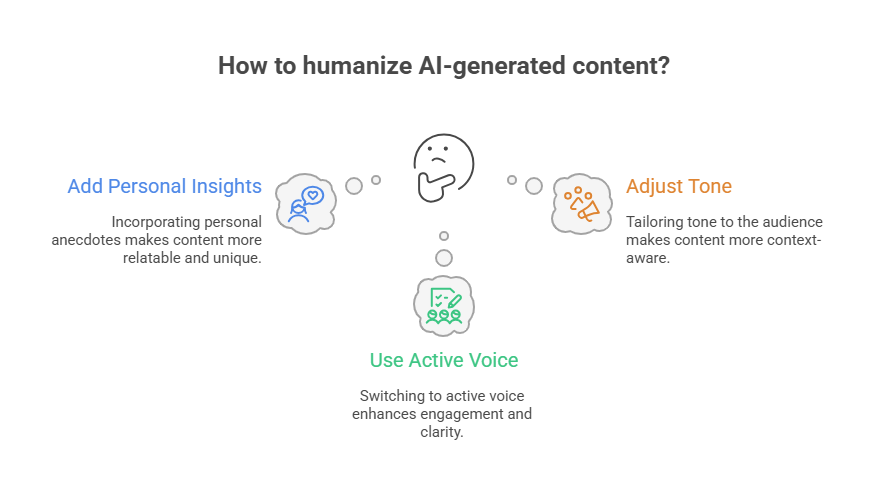In a world where AI content is everywhere, knowing how to avoid AI detection is crucial for writers and content creators. Whether you’re using AI tools to help with your writing or worried about your content being wrongly flagged, there are practical steps to make your writing pass AI detection tests without losing quality. Let’s explore some effective techniques to help your content read as authentically human.
“The world needs reliable AI detection tools; however, no AI detection tool is ever going to be 100% perfect. It’s important to understand the limitations of AI detector tools regarding AI detector accuracy, so that you can use them responsibly” -Jonathan Gillham, Originality.ai
Use Natural Language Patterns Clearly
Avoid overuse of specific phrases often flagged by AI tools
AI writing tends to use predictable transition phrases like “in conclusion,” “it is worth noting that,” or “on the other hand.” Detection tools spot these patterns easily. Vary your transitions and choose less common phrases. Watch for repetitive sentence structures that AI tools default to.
Break up long or uniform sentences with varying structure
AI detectors look for unnaturally consistent sentence lengths. Human writing naturally varies between short, punchy sentences and longer ones. Make sure your writing has this natural “burstiness.” Mix up sentence length. Start some with conjunctions. Ask questions? Insert brief statements. This variety makes your writing feel natural.
Example: Instead of “It is worth noting that AI writing can be repetitive”, try “AI writing often repeats patterns without realizing it.”
Include contractions and natural vocabulary variety
AI writing often avoids contractions and uses formal language. Use contractions like “don’t” instead of “do not” and add slang or idioms where appropriate. Surfer SEO suggests that maintaining original meaning while rephrasing with different words can help bypass AI content detection.
Manually Edit AI-Generated Content

Add personal insights or experience-based examples
AI content lacks personal experience. Adding your own anecdotes or unique perspectives makes content more human. Share relevant stories that illustrate your points. These personal touches are nearly impossible for AI to replicate and help create content that connects with readers on a deeper level.
Change passive voice to active where appropriate
AI writing often defaults to passive voice, which sounds stiff. Convert passive sentences to active ones. Instead of “The report was written by the team,” write “The team wrote the report.” Active voice creates more engaging content that feels human. Gravity Write points out that “the solution is not to avoid AI but to humanize AI content so it feels real”.
Adjust tone to sound more human and context-aware
According to Write Sonic, burstiness (the mix of short and long sentences) creates a natural rhythm that AI-generated text struggles to match. Consider your audience and adjust your tone accordingly. A finance post for teenagers should sound different from one for seasoned investors. This context awareness is something AI often misses.
Here are 5 AI detection tools
Surfer AI detector
Surfer’s AI detector helps identify if content might be flagged as AI-generated by search engines. It analyzes patterns and provides suggestions to make writing appear more human, useful for content marketers wanting to ensure their content performs well in search rankings while avoiding potential penalties.
Grammarly
Beyond grammar checking, Grammarly now includes AI detection. Grammarly will scan your text for AI in real time and tell you the percentage of your content it thinks is AI-written. This dual-purpose tool both improves writing and helps you understand how likely it is to be flagged as AI-generated.

Grammarly AI Detection
Copyscape
While primarily a plagiarism detector, Copyscape helps identify content that may be flagged by AI detection tools. It’s used by the world’s leading companies in publishing, Gen-AI, content marketing, SEO, education, research and more. Its algorithms check for uniqueness, which overlaps with many AI detection criteria.
Turnitin
Turnitin has evolved to become one of the most reliable tools for identifying AI-written text with high precision. It uses Natural Language Processing to understand semantics and employs statistical analyses to check for anomalies that might reveal AI-generated content, making it particularly challenging to bypass in academic settings.
Originality.AI
Originality.AI analyzes text patterns, sentence structures, and word choices to determine if content was created by AI models. Content creators and publishers use this tool to verify that their writers are producing original, human-written content rather than relying on AI generators.
Conclusion
Avoiding AI detection doesn’t mean abandoning AI tools. It’s about using these tools responsibly while adding your human touch. By incorporating natural language patterns, manually editing AI-generated content, and understanding how detection tools work, you can create content that remains undetected while maintaining high quality. The most effective approach combines AI efficiency with human creativity and personal experience.
FAQs
How to beat AI detectors for long-form content?
For long-form content, break it into sections and edit each with a slightly different style. Add personal stories throughout, vary sentence structures, and include unique insights. Write key sections entirely by hand, especially introductions and conclusions, as these often set the tone for AI detection tools.
Are there tools that help remove AI from generated content?
Yes, tools like Quillbot, Wordtune, and Hemingway Editor can help rephrase AI writing to make it more natural. Specialized tools like HumanizeAI are designed to help content pass AI detection. However, the most effective approach combines these tools with manual editing rather than relying solely on automated solutions.
Does paraphrasing help to remove AI footprints?
Paraphrasing helps if done thoughtfully. Simple synonym replacement isn’t enough, as AI detectors look for deeper patterns. Effective paraphrasing involves reimagining the content while preserving the core message. Add personal perspectives, use idioms naturally, and vary sentence structure to infuse content with a human voice that AI can’t easily replicate.



